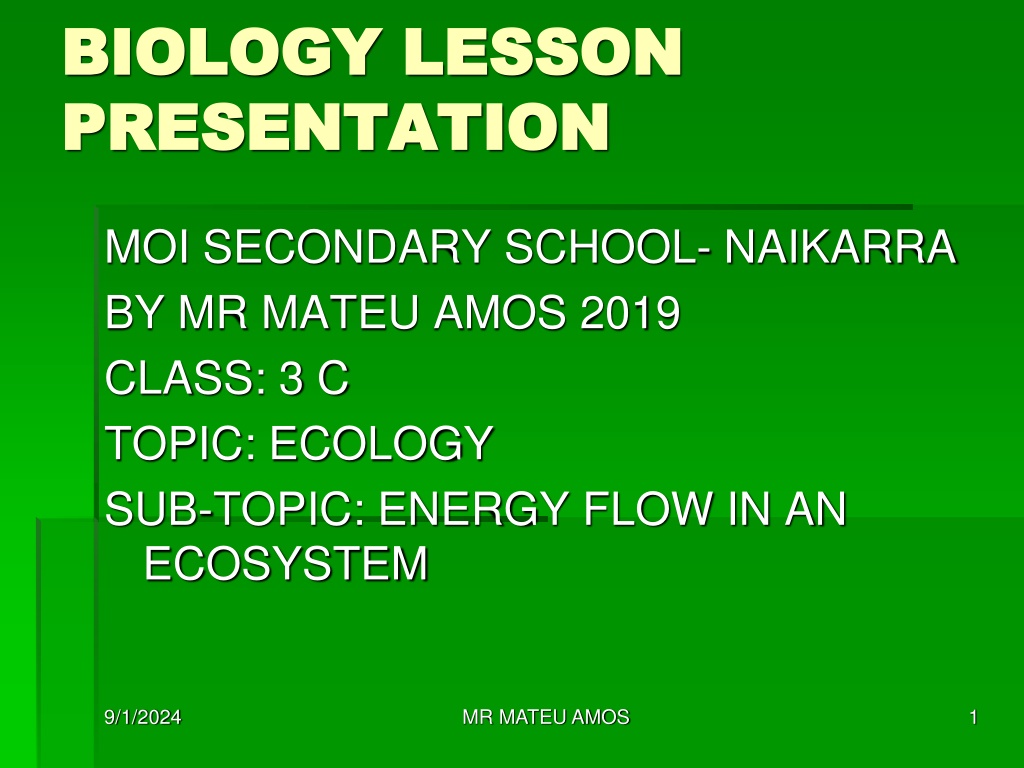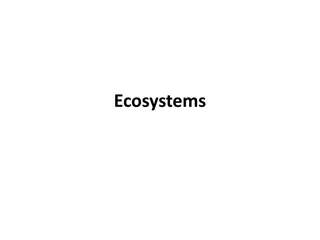Understanding Energy Flow in Ecosystems: A Comprehensive Overview
Energy flow in an ecosystem involves the transfer of energy from producers to consumers through different trophic levels, with only a small fraction of energy being passed on at each level. This process is essential for sustaining life within an ecosystem, highlighting the interconnectedness of all organisms and the efficient utilization of energy. The flow of energy follows a specific sequence, starting from producers like plants, through primary, secondary, tertiary consumers, and finally to decomposers, showcasing the intricate balance of nature.
Download Presentation

Please find below an Image/Link to download the presentation.
The content on the website is provided AS IS for your information and personal use only. It may not be sold, licensed, or shared on other websites without obtaining consent from the author. Download presentation by click this link. If you encounter any issues during the download, it is possible that the publisher has removed the file from their server.
E N D
Presentation Transcript
BIOLOGY LESSON BIOLOGY LESSON PRESENTATION PRESENTATION MOI SECONDARY SCHOOL- NAIKARRA BY MR MATEU AMOS 2019 CLASS: 3 C TOPIC: ECOLOGY SUB-TOPIC: ENERGY FLOW IN AN ECOSYSTEM 9/1/2024 MR MATEU AMOS 1
Energy Flow in an Eco Energy Flow in an Eco- -System Trophic Level It is a level stage of feeding within a food chain. Light energy from the sun is trapped by plants and used to build chemical food substances like glucose in the process of photosynthesis. Green plants are known as producers. They are eaten by herbivorous animals that form primary consumers. Energy is transferred from producers to primary consumers. Primary consumers are eaten by carnivorous animals that form secondary consumers. The energy is transferred from primary consumers to secondary consumers. System 9/1/2024 MR MATEU AMOS 3
The secondary consumers are eaten by tertiary consumers who are also carnivorous animals. Energy is transferred from secondary to tertiary consumers. The tertiary consumers are eaten by quaternary consumers. The energy is transferred from tertiary to quaternary consumers. Plants Grasshopper Bird Man Vulture When plants and animals die, their bodies are eaten by saprophytic Bacteria and Fungi 9/1/2024 MR MATEU AMOS 4
Energy is finally released and lost to the surrounding. At every level; of feeding, only small fraction of energy is transferred from one Trophic level to another. The rest is lost as heat energy during respiration. Some is locked up in undigested and indigestible waste and released during defecation/excretion. 9/1/2024 MR MATEU AMOS 5
SUMMARY OF ENERGY FLOW 9/1/2024 MR MATEU AMOS 6
9/1/2024 MR MATEU AMOS 7
FOOD CHAIN FOOD CHAIN It is the linear nutritional sequence of feeding describing the flow of energy from the producers to successive consumers at each trophic level. Grass is eaten by a grasshopper which is eaten by the bird. Grass Grasshopper The arrow points to the eater and shows the direction of energy flow. Food chains always begin with producers. When decomposers e.g. bacteria and fungi are included in the food chain, they are always placed at the end of the food chain. Bird 9/1/2024 MR MATEU AMOS 8
FOOD WEB FOOD WEB It is the combination of inter-connected food chains where different members of different levels feed on more than one group of members. A food web is made up of many food chains that are intertwined. Grass Cricket rog Raccoon 9/1/2024 MR MATEU AMOS 9
Hawks Weasels Raccoons Mice Grass 9/1/2024 MR MATEU AMOS 10
9/1/2024 MR MATEU AMOS 11























